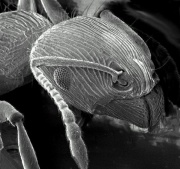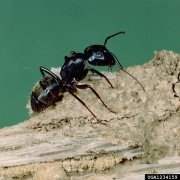Difference between revisions of "Ant"
Jump to navigation
Jump to search
m (Text replace - "== Authority ==" to "== Sources Checked for Data in Record ==") |
|||
| (One intermediate revision by the same user not shown) | |||
| Line 10: | Line 10: | ||
carpenter ant (''Camponotus spp.)'' | carpenter ant (''Camponotus spp.)'' | ||
| − | == | + | == Physical and Chemical Properties == |
| − | Size range: about 2 to 25 millimeters (about 0.08 to 1 inch) | + | * Size range: about 2 to 25 millimeters (about 0.08 to 1 inch) |
| − | + | * Color: may be be yellow, red, black, or brown | |
| − | Color: may be be yellow, red, black, or brown | + | * Body: head (large), thorax, abdomen (separated from thorax by 1-2 nodes) |
| − | + | * Antenna: bent, usually the outer segments are larger forming a club | |
| − | Body: head (large), thorax, abdomen (separated from thorax by 1-2 nodes) | + | * Legs: six, connected to thorax |
| − | |||
| − | Antenna: bent, usually the outer segments are larger forming a club | ||
| − | |||
| − | Legs: six, connected to thorax | ||
| − | |||
| − | |||
| − | |||
| − | |||
== Additional Images == | == Additional Images == | ||
| Line 34: | Line 26: | ||
</gallery> | </gallery> | ||
| + | ==Resources and Citations== | ||
| + | |||
| + | * MuseumPest.net at [https://museumpests.net/ Link] | ||
| − | + | * Eric H. Smith, Richard C. Whitman, ''NPMA Field Guide to Sturctural Pests'', National Pest Management Association, Fairfax VA, 2005. | |
* Random House, ''Webster's Encyclopedic Unabridged Dictionary of the English Language'', Grammercy Book, New York, 1997 | * Random House, ''Webster's Encyclopedic Unabridged Dictionary of the English Language'', Grammercy Book, New York, 1997 | ||
| Line 41: | Line 36: | ||
* ''The American Heritage Dictionary'' or ''Encarta'', via Microsoft Bookshelf 98, Microsoft Corp., 1998 | * ''The American Heritage Dictionary'' or ''Encarta'', via Microsoft Bookshelf 98, Microsoft Corp., 1998 | ||
| − | * ''Encyclopedia Britannica'', http://www.britannica.com Comment: "ant." | + | * ''Encyclopedia Britannica'', http://www.britannica.com Comment: "ant." Accessed 21 Jan. 2005 . |
| − | * Wikipedia | + | * Wikipedia: http://en.wikipedia.org/wiki/Ant (Accessed Jan 2005) |
[[Category:Materials database]] | [[Category:Materials database]] | ||
Latest revision as of 12:43, 27 April 2022
Description
Any member of over 8000 species of insect in the Formidicae family. Ants live in organized colonies generally separated into three classes of queens, males, and workers. Ants have a six legs, bent antennae, and a segmented body with large head, thorax, and abdomen. Their life cycle, from egg to adult, is 8 to 10 weeks. Adult worker ants can live up to 7 years. Ants are scavengers and feed on either plant or animal products. Carpenter ants are one of the most damaging species to historic homes. Found in warm, moist climates, they damage wood by hollowing out spaces for nests.
Synonyms and Related Terms
carpenter ant (Camponotus spp.)
Physical and Chemical Properties
- Size range: about 2 to 25 millimeters (about 0.08 to 1 inch)
- Color: may be be yellow, red, black, or brown
- Body: head (large), thorax, abdomen (separated from thorax by 1-2 nodes)
- Antenna: bent, usually the outer segments are larger forming a club
- Legs: six, connected to thorax
Additional Images
Resources and Citations
- MuseumPest.net at Link
- Eric H. Smith, Richard C. Whitman, NPMA Field Guide to Sturctural Pests, National Pest Management Association, Fairfax VA, 2005.
- Random House, Webster's Encyclopedic Unabridged Dictionary of the English Language, Grammercy Book, New York, 1997
- The American Heritage Dictionary or Encarta, via Microsoft Bookshelf 98, Microsoft Corp., 1998
- Encyclopedia Britannica, http://www.britannica.com Comment: "ant." Accessed 21 Jan. 2005 .
- Wikipedia: http://en.wikipedia.org/wiki/Ant (Accessed Jan 2005)




